CAMCORDERS AS DIGITAL STILL
CAMERAS
by John Henshall
If you feel you can't afford a
digital still camera, it may surprise you to discover that you
already have the most important part of the kit already. It's
probably been stuffed away in the cupboard since the last family
holiday in Torremolinos four or five years ago. Dust it off: a little
lateral thought could save you a small fortune.
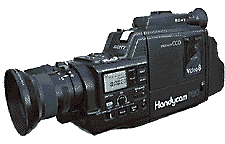 Your
old camcorder is already an electronic camera. Like its latest
digital still camera cousins, it has a CCD image sensing chip to
convert light into electrons, instead of using film. The only thing
it doesn't have is the part that converts the electronic picture to
digital. We'll show you how to get round this.
Your
old camcorder is already an electronic camera. Like its latest
digital still camera cousins, it has a CCD image sensing chip to
convert light into electrons, instead of using film. The only thing
it doesn't have is the part that converts the electronic picture to
digital. We'll show you how to get round this.
Your camcorder has more facilities than a digital still camera
costing over a grand - like a twenty five frames-per-second
continuous motor drive. Moving images are just a rapid succession of
stills and a European camcorder takes twenty five pictures per
second. That will make sure you don't miss Granny's flash of knickers
as she does the knees-up at the wedding. A one hour tape - removable
re-usable image storage media - holds 90,000 images. A ninety minute
tape holds 135,000 images. No digital still cameras have such
features but every camcorders does.
Your camcorder probably has a zoom lens, enabling you to get tight
closeups and expansive wide  angles.
It may have macro, to fill the frame with a butterfly on a flower.
Making up retrospective albums becomes easy as this shot of my
daughter Annelies, taped seventeen years ago, shows.
angles.
It may have macro, to fill the frame with a butterfly on a flower.
Making up retrospective albums becomes easy as this shot of my
daughter Annelies, taped seventeen years ago, shows.
You'll be kicking yourself now if you flogged your old camcorder
for a tenner at the car boot sale last summer.
Maybe it's time you treated yourself to one of the new 'DV'
(Digital Video) jobs? They give much higher quality pictures than the
older camcorders. We'll tell you how to use them as a digital still
camera, capable of blasting 640 x 480 pixel digital still cameras out
of the water. You'll also be able to film weddings and barmitzvahs,
complete with digital stereo sound.
WHAT YOU NEED
Apart from a camcorder, you need a
computer. Anything from a '486 up, or any Mac or PowerMac. Look on
the back, it's a bit of a long shot but it might just be one of those
which already has AV (audio-visual) inputs.
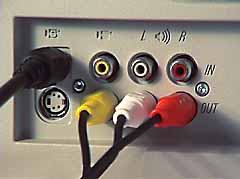 Look
for a cluster of phono sockets, perhaps coloured yellow (video), red
and white (audio) and also a socket about 9mm diameter with four pins
and a small rectangular peg (S-Video).
Look
for a cluster of phono sockets, perhaps coloured yellow (video), red
and white (audio) and also a socket about 9mm diameter with four pins
and a small rectangular peg (S-Video).
If you've got these, you've got a built in video digitiser free
and all you need is the cable to connect your camcorder to the
computer. Use the S-Video sockets if you've got them. They keep the
video brightness and colour signals separate, producing better
quality pictures. If you can't use S-Video, get a good quality phono
lead intended to carry video.
On The Cards
If you don't have AV inputs, you
need a video 'grabber', either inside or outside the computer
case.
Installing an internal card involves taking the cover off your PC.
Though it's not beyond the capabilities of someone who's practical
and careful, if you have any doubts at all get a qualified service
engineer to install it. These cards may also give you on-screen tv
and teletext, with video grabbing almost incidental. Unfortunately
they don't give very sharp colour definition.
Get Snappy
 But,
hey, why bother with all this when you can buy a no-compromise
digitising device which just plugs into the parallel (printer) port
in five seconds? It's called Snappy, made in the USA by Play Inc.
Good news is that the UK price has just been halved, to £95.
There's no other device like it on the market. Don't risk poking
about inside your computer: buy one of these. It's easy, it's
safe.
But,
hey, why bother with all this when you can buy a no-compromise
digitising device which just plugs into the parallel (printer) port
in five seconds? It's called Snappy, made in the USA by Play Inc.
Good news is that the UK price has just been halved, to £95.
There's no other device like it on the market. Don't risk poking
about inside your computer: buy one of these. It's easy, it's
safe.
Snappy is a wacky design with two recessed blue thumbscrews which
secure it firmly to the parallel port. It's light in weight but a bit
bulky so connect it using a printer extension cable, which also
enables you to have Snappy wherever it's convenient to connect the
video cables. Apart from the 25 pin connector there are just two
phono sockets: one marked 'Video In', the other 'Video Thru'. Video
thru loops the pictures from the camcorder through to a television
set - easier than peering at the small preview on the computer
monitor.
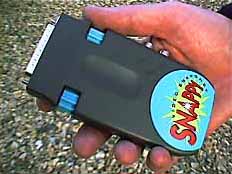 Snappy
is powered by a standard 9 volt internal battery, said to be good for
a thousand snaps. It has a small (160 x 120 pixels) black and white
preview window which updates twice a second with the incoming
signal.
Snappy
is powered by a standard 9 volt internal battery, said to be good for
a thousand snaps. It has a small (160 x 120 pixels) black and white
preview window which updates twice a second with the incoming
signal.
If you haven't got video connected, you see a snow storm - like a
tv set with the aerial out. To grab a still from your video, press
the 'Snap' button. There is a delay between the frame you see when
you click 'Snap' and the frame you get - irritating if you're trying
to grab the best frame of the children playing.
Version 3 of the software has just been announced in the USA,
looking as though it has been redesigned by Kai Krause. It has a
'live' colour preview and a shorter delay between clicking snap and
the frame you get but version 3 is only available for the American tv
standard (NTSC) at the moment.
And sorry, Mac users, Snappy is only for PCs.
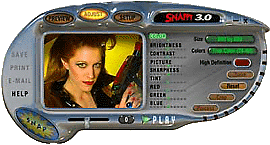
It's so hot it's
burning
If you haven't got a camcorder, but
don't mind spending upwards of a grand on the latest gear, the future
- and the best stills - are here now in the form of DV
camcorders. JVC, Panasonic, Sharp, Sony and now Canon all have DV
camcorders, ranging upwards from £1,000. This is a hot area to
watch.
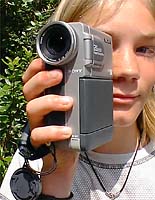

The Sony DCR-PC7E Digital
Camcorder
The best way to acquire still (and moving) digital images from a
DV camcorder is directly into your computer is using a new digital
connection interface called IEEE1394, popularly known as FireWire,
though some manufacturers want it to be called 'i.Link'. Memorable,
eh?
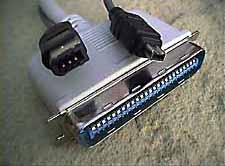 FireWire's
main advantage is its fantastic speed - it will transfer data between
devices at speeds up to up to 400Mbps (million bits per second).
That's about 50 Megabytes per second. The other big advantage is its
ease of connectivity via small thin cables, with tiny connectors and
the facility to 'hot plug' devices without powering down the
computer.
FireWire's
main advantage is its fantastic speed - it will transfer data between
devices at speeds up to up to 400Mbps (million bits per second).
That's about 50 Megabytes per second. The other big advantage is its
ease of connectivity via small thin cables, with tiny connectors and
the facility to 'hot plug' devices without powering down the
computer.
Not to get too technical, it is isochronous - how's that for a
good new word to drop in conversation? - which means that it delivers
data at a pre-determined fixed rate. This is essential for
applications such as video, which needs a constant stream at about
25MB per second. Other systems, which deliver data in fits and
starts, are not reliable enough. FireWire is.
Radius PhotoDV
Radius PhotoDV consists of a FireWire card for PCI Macs and a
PhotoShop plug-in. It also comes with Color It! in case you haven't
got PhotoShop. The FireWire speed advantage is immediately noticeably
when you acquire digital stills from a DV camcorder.
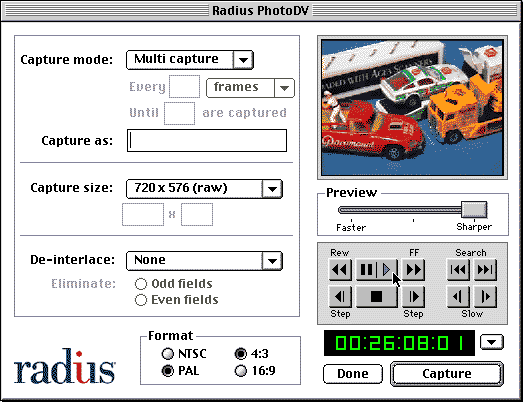
When you've found the precise frame you want, it takes less than
two seconds to capture it into the computer.The system is so simple,
effective and fast to use that it makes you never want to go back to
using a low resolution digital still camera with slow serial
interface.
Moving Images
When you have a DV camcorder, you'll
soon be itching to 'non linear' edit your home video movies on the
computer, using software such as Adobe Premiere and Strata (formerly
Avid) VideoShop. Radius have just released a FireWire video editing
system in the USA for $999, which uses the already digitised sound
and video direct from the camcorder. A European version is expected
in the second quarter of 1998. Start saving now for a really fast
computer and hard drive.
Now go to the next page to see how the various bits of kit
compare - This is an in-depth look at the capabilities of these
cameras.

This article first appeared in "Digital PhotoFX"
magazine, Issue 2.
IMPORTANT NOTICE
This document is Copyright © 1998 John Henshall. All rights
reserved.
This material may only be downloaded for personal non-commercial use.
Please safeguard the future of online publishing by respecting this
copyright and the rights of all other authors of material on the
Internet.


 Your
old camcorder is already an electronic camera. Like its latest
digital still camera cousins, it has a CCD image sensing chip to
convert light into electrons, instead of using film. The only thing
it doesn't have is the part that converts the electronic picture to
digital. We'll show you how to get round this.
Your
old camcorder is already an electronic camera. Like its latest
digital still camera cousins, it has a CCD image sensing chip to
convert light into electrons, instead of using film. The only thing
it doesn't have is the part that converts the electronic picture to
digital. We'll show you how to get round this. angles.
It may have macro, to fill the frame with a butterfly on a flower.
Making up retrospective albums becomes easy as this shot of my
daughter Annelies, taped seventeen years ago, shows.
angles.
It may have macro, to fill the frame with a butterfly on a flower.
Making up retrospective albums becomes easy as this shot of my
daughter Annelies, taped seventeen years ago, shows. Look
for a cluster of phono sockets, perhaps coloured yellow (video), red
and white (audio) and also a socket about 9mm diameter with four pins
and a small rectangular peg (S-Video).
Look
for a cluster of phono sockets, perhaps coloured yellow (video), red
and white (audio) and also a socket about 9mm diameter with four pins
and a small rectangular peg (S-Video). But,
hey, why bother with all this when you can buy a no-compromise
digitising device which just plugs into the parallel (printer) port
in five seconds? It's called Snappy, made in the USA by Play Inc.
Good news is that the UK price has just been halved, to £95.
There's no other device like it on the market. Don't risk poking
about inside your computer: buy one of these. It's easy, it's
safe.
But,
hey, why bother with all this when you can buy a no-compromise
digitising device which just plugs into the parallel (printer) port
in five seconds? It's called Snappy, made in the USA by Play Inc.
Good news is that the UK price has just been halved, to £95.
There's no other device like it on the market. Don't risk poking
about inside your computer: buy one of these. It's easy, it's
safe. Snappy
is powered by a standard 9 volt internal battery, said to be good for
a thousand snaps. It has a small (160 x 120 pixels) black and white
preview window which updates twice a second with the incoming
signal.
Snappy
is powered by a standard 9 volt internal battery, said to be good for
a thousand snaps. It has a small (160 x 120 pixels) black and white
preview window which updates twice a second with the incoming
signal.


 FireWire's
main advantage is its fantastic speed - it will transfer data between
devices at speeds up to up to 400Mbps (million bits per second).
That's about 50 Megabytes per second. The other big advantage is its
ease of connectivity via small thin cables, with tiny connectors and
the facility to 'hot plug' devices without powering down the
computer.
FireWire's
main advantage is its fantastic speed - it will transfer data between
devices at speeds up to up to 400Mbps (million bits per second).
That's about 50 Megabytes per second. The other big advantage is its
ease of connectivity via small thin cables, with tiny connectors and
the facility to 'hot plug' devices without powering down the
computer.